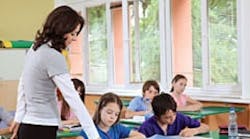Opponents to a recent bond referendum argued that new buildings did nothing to improve education in the district: “Shiny new schools do not reduce class size or give them better test scores.”
But guess what? Shiny new schools do improve student test scores! The Carnegie Foundation for the Advancement of Teaching found that student attitudes about education directly reflect their learning environment. Specific building features related to human comfort (e.g. building age, climate control, indoor air quality, lighting, acoustical control) have been shown to influence student achievement.
Research examining student achievement scores and school facilities' quality ratings (using the percentage of students in free- and reduced-price-lunch programs as a means to control for socioeconomic status) has shown differences of between five and 17 percentile points in achievement scores of students in functional buildings compared with scores of students in poor buildings.
Students in non-modernized buildings scored lower on basic skills assessments than those students in modernized or new buildings. In one study, building age accounted for as much as 3.3 percent of the variance in students' scores on the Iowa Test of Basic Skills.
A before-and-after study of renovated schools in Syracuse, N.Y., found improved achievement among students in the refurbished buildings. Another research effort compared students at the newest and the oldest buildings in a district. Those attending the new school out-performed their peers in the older school on all available measures of achievement.
“Classroom Acoustics,” a guide published by the Acoustical Society of America, states that higher student achievement is associated with schools that have less noise interference.
In Washington, D.C., researchers looked at public schools to determine how parental involvement and building condition related to student achievement. Test scores increased an average of 5 percent as the condition category of school buildings improved from poor to fair condition and from fair to excellent condition. Students in buildings rated as poor had test scores that averaged 5 percent lower than students in buildings categorized as fair and 10 percent lower than students in buildings categorized as excellent.
The nature and quality of the built learning environment also have been shown to affect teacher attitudes, behaviors and performance. Studies have concluded that teacher retention and attrition rates are affected by the quality of school facilities.
The relationship between the quality of a school facility and a school's engagement with the community presents an important focus for research. Communities that take an active role in their schools come to understand the needs associated with teaching and learning, including physical environments. Poor-quality school buildings are likely to be perceived by inhabitants and community members as an indication of a lack of commitment to the aims of schooling.
Specific design classifications that have been related to improved student achievement on standardized tests include pathways encouraging ease of movement, positive outdoor spaces, large-group meeting spaces, instructional neighborhoods, ample egress, natural light and views, the presence of technology for teachers, and pleasing or appropriate color, defined as age- and activity-appropriate color choices.
The aesthetic features of a school can foster a strong sense of belonging that, in turn, can generate an enthusiasm for learning.
Rydeen, FAIA, is AS&U's Facility Planning columnist and an architect/facility planning specialist with ATS&R, Minneapolis.



